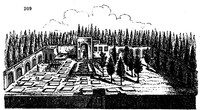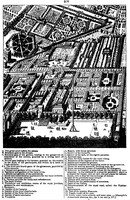740. Cemeteries. There are said to be 1001 mausoleums at Shiraz; those of Chodsja Hafiz and Saadi Sjeraft (both celebrated poets) are the most beautiful. The burial-place of the first is situated at Muselli, an estate possessed by Hafiz, who, it is remarked, was not buried by the nation, but had the expenses of his funeral defrayed out of his own private fortune. His cemetery is square and spacious, shaded by poplars (a rare tree in Persia), and having a lion carved in stone on each side of the entrance. The wall is built of brick, and coincides in direction with the cypress trees of the surrounding garden. The ground is strewed with tombstones, and divers sepulchral memorials of those who had desired to be buried under the guardian influence of the poet. Entering from the neighbouring garden, which was bequeathed to the cemetery, the keeper conducts a stranger into the place of the sepulchre. This is surrounded by lattice-work, and contains three tumuli besides the grave of the poet; one encloses the remains of a secular prince, and the other two illustrious individuals, who, when living, were disciples of Hafiz (fig. 209.). In the place of the sepulchre, sits a priest, who repeats verses from the Koran in praise of the illustrious dead, and enumerates their virtues; when he has finished, another, and afterwards a third, in the open burying-place, takes up the same theme; so that the lamentations are incessant. The tombs are placed in a row; and the form of all of them is the same. They are about the size of a sarcophagus, and have each a large stone, about a man's height, at both ends. The stone of which they are made is of a common kind, and unpolished. On each side are sculptured verses from the Koran, and on the stones placed at the feet, are elegant epitaphs. Hafiz died A. D. 1340. (Kï¾µmpfer's Amï¾µn. Exot., &c., fas. ii. rel. vi. p. 367.)



